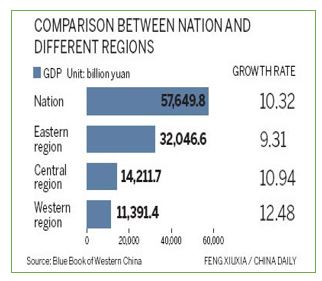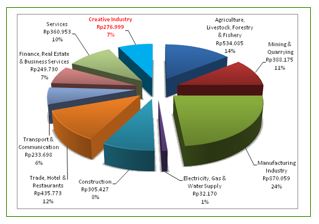China's Western Region Emerges as a new Economic Driver

Key Points:
- China has approved 152 infrastructure projects worth a combined USD $549.39 billion in its western regions since late 2016
- The potential huge consumption market in the western region will become more appealing to investors if transport links are effective and cost-competitive.
- Through involvement in the âOne Belt, One Roadâ strategy is forecasted accelerate local transport infrastructure construction and promote inter-regional trade
Introduction
China with its vast territory faces the problem of uneven development in different regions. The economic development of China, which has a territory of 9.6 million square km, is likened to âan eagle spreading only one wing for flightâ. This implies that while the eastern area has developed swiftly during the 20-odd years of reform and opening, the western region has lagged behind. Hence, the Chinese Government has decided to intensify the development of the western region as a means of enabling China to spread both wings and quicken the progress of economic development in China as a whole.
Economic Development
Figure 1: Massive Economic Growth in China's Western Provinces

China's attempt to develop its western regions has had positive effects on the economic development of various sectors, especially in the Chengdu-Chongqing Districts (refer to Figure 2 above). While massive investment has boosted the region's output, effectively raising the GDP in all western regions, the project failed to achieve its goal of eliminating the economic gap between China's East and West.
Figure 2: Increasing Importance of China Western Region

From 2008 to 2017, Xinjiang and Guangxi displayed an annual GDP percent increase of as high as 30%[1]. China's western regions have reported an annual average economic growth rate of 10.6% for six years in a row[2] (refer Figure 2 above). The combined GDP of the western regions reached USD $3.33 trillion in 2017, compared with USD $1.66 trillion in 2000[3]. Initiatives encouraging Chinese from wealthier and more crowded regions of China to move to the less crowded western regions has resulted in population growth in [a few cities], most notably Qinghai with its increase of 12.6%[4].
Analysts believe that the large-scale development of the western region with the aim of expediting the progress of the central and western regions is an important policy-decision geared toward the new century. The development of the eastern coastal areas over the past 20-years has promoted the sustained and rapid progress of China's economy[5]. Likewise, the large-scale development of the western region, which will provide the eastern and central regions with a tremendous market and broad prospects for development, will surely bring greater prosperity to the national economy[6].
Market watchers added that in the future, the Government's construction investment will shift toward the central and western regions, and the western region in particular. The eastern area will also reinforce its support of the western region through various means. To help the western region quicken the pace of reform and opening and improve its investment environment, the Chinese Government will adopt more effective measures to attract domestic and overseas funds, technology and professionals to the region.
Sustainable Development
Advancing the large-scale development of the western region is a new subject under new historical conditions. The methods used in the development of the east certainly will not work in the west. This is because the eastern and western regions not only differ greatly in natural resources, historical backgrounds, and other factors but also in the starting point of economic development and the existing domestic and international environment[7].
The State Development Planning Commission stressed that the western region should take the strengthening of ecological construction and environmental protection as a basic starting point for its large-scale development[8]. This point of view has been generally recognized by leaders in the western region. Compared with the development of the east two decades ago, the large-scale development of the western region mainly differs in taking the sustainable development as a principal strategy in a bid to maintain the beautiful landscape while advancing economic construction.
[1] The Economist, May 199
[2] China Statistical Yearbook 2017, National Bureau of Statistics of China
[3] China's Western Development Program: Its Rationale, Implementation, and Prospects". Modern China. Sage Publications.
[4] Developing China's West: A critical Path to Balanced National Development.: The Chinese University Press, 2017
[5] National Development and Reform Commission.
[6] Bloomberg
[7] National Development and Reform Commission.
[8] National Development and Reform Commission.
Figure 3: China's Western Region GDP Growth

The western region, as the source of Yangtze, Yellow, Pearl, and other large rivers, plays an important role in maintaining the nation's GDP growth rate (refer to Figure 3 above). A project involving the return of farmland to forested areas, an important component of the western region's development program and a top environment construction scheme, has been launched.
Under the energetic support of the Central Government, Yunnan, Guizhou, Sichuan and Chongqing have decided to invest 120 billion USD in the coming decade to intensify reforestation along the upper and middle reaches of Yangtze and Pearl rivers[9]. North-western Xinjiang Uygur Autonomous Region plans to invest USD 10 billion to treat China's largest continental river, the Tarim, which is partially dried up. Shaanxi Province will invest USD $20 billion in an ecology recovery project[10].
[9] Bloomberg
[10] Bloomberg
Figure 4: China's Look West Development Policy

In addition, China will further improve its method of assistance in the development of the western region by intensifying its Westward development policy and using market forces to attract domestic and overseas capital, technology and talents[11] (refer Figure 4 above).
For the year 2017 alone, the Chinese government
will formulate more preferential policies to attract foreign capital and use
more loans offered by international organizations in the western region's
construction projects. China also plans to use a fairly great part of the
government debts issued this year and over the next four years in the region's
infrastructure construction, including loans extended to enterprises
participating in the western region's construction.
[11] China Statistical Yearbook 2017, National Bureau of Statistics of China
Inflow of Foreign Investment
Figure 5: Foreign Investment in China's Western Region

China's construction of transportation infrastructure facilities in the west, including highways, railways, and airports, must be sped up in advance of other sectors. To date, China has, to a certain extent, opened more than a dozen sectors in the west to foreign investors, including banking, insurance, and telecommunications, and has relaxed conditions for foreign businesses to set up enterprises in the region and on their share of stocks.
China has already has attracted foreign banks to set up representative offices and branches in the west and encourages foreign businesses to invest in projects in agriculture, water conservancy, transportation, energy, raw materials and environmental protection[12]. In fact, compared with the development of the east, the development of the western region now faces different subjective and objective conditions. By the end of 2018, China's foreign exchange reserves had exceeded US$155 billion, which was inconceivable two decades ago[13]. In addition, after more than 20-years of investment exploration in China, foreign businesses have both established confidence and accumulated experience in China's construction and development.
Furthermore, the prospects for China's WTO accession are becoming increasingly clear. These factors favour foreign investment in the west. By the end of June 2018, the western region had established more than 15,000 foreign-funded enterprises, involving a total investment of US$70 billion[2]. Additionally, at the end of September 2018, Sichuan Province had used nearly US$13 billion in foreign capital, ranking the province first among all the provinces and autonomous regions in the west.
Figure 6: FDI Flows into Various Sectors in Western China

At present, nearly 40 multinational companies have invested in various businesses or built factories in the province, including the Motorola, Proctor & Gamble, Siemens, and Toyota. Motorola's investment in Sichuan has exceeded US$300 million[15] (refer to Figure 6 above). Only, a short time ago, Motorola established the Motorola City in the provincial capital Chengdu, a major step in exploring west China's markets in the wake of investing USD $100 million in establishing a network research and development center in Chengdu[1]. Meanwhile, Yunnan Province now registers more than 320 projects funded by Taiwan-based businesses, with combined investment surpassing US$177 million[2]. These projects are mainly involved in catering service, timber processing, and real estate development.
[12] Bloomberg
[13] China Statistical Yearbook 2017, National Bureau of Statistics of China
[14] China Statistical Yearbook 2017, National Bureau of Statistics of China
[15] Bloomberg
[16] National Development and Reform Commission.
[17] The Economist, May 2018
[18] National Development and Reform Commission.
[19] Bloomberg
Conclusion
To conclude, China has been investing heavily on transportation infrastructure in a bid to boost development, ease poverty and better integrate its remote and sometimes restive western regions into the national economy. Major projects have always been a powerful measure to promote development in the west[1].
At present, fifty two major projects had already
been completed with the remaining 100 set to be finished by 2023[2].The
projects include 12 new airports at a total cost of USD $162.4 billion, as well
as roads and railways, water diversion facilities and hydroelectric power
stations[3].
It's forecasted by 2023, China's western regions will have an additional 8,751 kilometres
of highways, 3,219 kilometres of new high-speed rail and 187 plants of new energy
generation capacity[4].
It's imperative that China's western regions needed to strengthen economic ties
with neighbouring countries in central or Southeast Asia and work to ease their
dependence on heavy industries.
[19] Bloomberg
[20] China Statistical Yearbook 2017, National Bureau of Statistics of China
[21] National Development and Reform Commission.
The post China's Western Region Emerges as a new Economic Driver appeared first on Foundation Capital.
